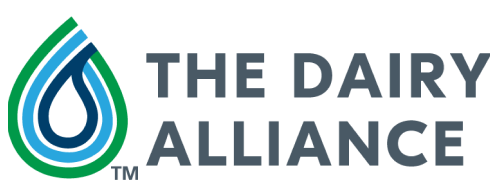Discover Sustainable Dairy Farming
How does the modern dairy farm fit into sustainability goals? You may be surprised how today’s dairy farms focus on reducing the waste of resources—and even helping reduce the waste of other industries. Read on to discover sustainable dairy farming practices at The Dairy Alliance.
Why Sustainable Dairy Farming Matters
Did you know that modern US dairy farming practices have a low impact on the environment? The dairy industry contributes less than 2% of total US greenhouse gas emissions. Seriously! Together, plant and animal agriculture contributes 11% of total U.S. greenhouse gas emissions.
Comparing 1944 to 2007, dairy farming practices in the US took 90% less land, 65% less water, and a 63% smaller carbon footprint to produce a gallon of milk over that 63-year period. Manure waste decreased by 76% with 79% fewer cows and 77% less feed needed despite milk production increasing by over 58% in that period.
With sustainability efforts beginning decades before many other industries, dairy farmers act as environmental stewards and are at the forefront of sustainable innovations. It’s just one of many reasons to choose real milk.
Reducing Environmental Footprint
The dairy industry continues to reduce its footprint. The dairy industry is introducing a variety of practices to make the most of limited resources while keeping cows happy and milk tasty and nutritious.
One example of this is the reduction of water usage through recycling. On average, water is recycled four times on a dairy farm.
First, water is used in the storage tank and/or for drinking water. Water is used to cool fresh milk sent to tanks from the parlor. The water is still clean, so it can then be used as drinking water for the herd.
A farm may have special uses for the clean water throughout the year. For example, farmers may use misters in the barns to keep their cows cool on hot days.
Next, the water is collected and used to clean equipment and barns.
Finally, the water is used for watering crops. This now nutrient-rich water is used to grow the farm’s crops, like the feed cows will later eat.
Implementing eco-friendly farming practices like this means that dairy farmers can continue to produce nutritious milk for generations to come. With families coming together to run the farm and care for the animals that live there, caring for the planet, minimizing greenhouse gas emissions, and keeping the process as sustainable as possible is a priority for farmers.
Promoting Soil Health and Nutrient Management
Healthy soil is key for both a sustainable future for dairy farming and for the planet. Sustainable dairy farming practices (and some general agricultural practices, too) include planting cover crops to protect the soil in the off-season, rotating crops grown to maintain variance and replenish soil health, and using low-till or no-till techniques to minimize disturbance to the soil. Other practices that contribute to soil health include using manure as a natural fertilizer and using recycled, enriched water in irrigation.
Renewable Energy and Waste Management
Energy is needed to run the facilities and to power equipment used daily on the dairy farm. Some farmers are implementing a sustainable practice using anaerobic digesters to capture the once untapped energy found in a plentiful resource on the dairy farm: manure.
Anaerobic digesters break down manure and food waste using bacteria in a sealed container with no oxygen. The energy created can be reused as electricity, heat, or natural gas, while the dried solids remaining can be used as a fertilizer. This energy is used to power their farm or sold back to the grid to power their local towns.
This isn’t the only way farm play a part in reducing food waste. Energy was used to grow and transport food, so no one wants this energy use to be wasted. Cows are the ultimate upcyclers due to their four-chambered stomachs. Cows can digest food that humans cannot, meaning cows can reduce the amount of food waste that makes it into landfills. Dairy farmers include foods that are indigestible to humans but delicious to a dairy cow in the herd’s diet, like almond hulls, citrus pulps, or brewers' grains.
To discover more ways dairy farmers are implementing sustainable dairy farming practices, check out our short documentary, The Dairy Truth.




